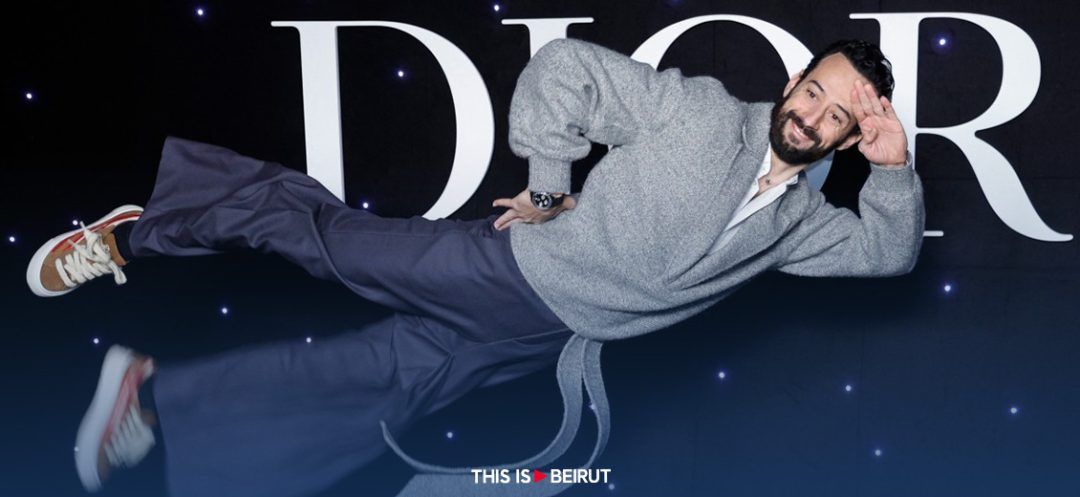
©French dancer Mathieu Forget attends the Dior Homme Menswear Ready-to-wear Fall-Winter 2024/2025 collection. Photo by Geoffroy Van Der Hasselt/AFP)
In a remarkable display of creative ingenuity, Dior, under the creative direction of Kim Jones, presented a menswear collection that paid homage to the legendary ballet dancer Rudolf Nureyev. This collection was not just a nod to Nureyev’s iconic status in the world of dance but also a tribute to Jones’s uncle, Colin Jones, a classical dancer and photojournalist known for his intimate photography of Nureyev.
The collection revealed amidst the stirring brass and strings of Sergei Prokofiev’s Romeo and Juliet, was set on a dynamic, steel-gray stage that transformed into spinning platforms, reminiscent of a giant music box. This setting was not just a backdrop but an integral part of the storytelling, reflecting the spirit of performance that heavily influenced Kim Jones’s designs.
Kim Jones’s approach to the collection was deeply rooted in the fusion of performance art with everyday fashion. He aimed to create stage wear that could be part of an “extravaganza at home,” blending the theatrical with the practical. This philosophy was evident in every piece of the collection, which gracefully walked the line between performance and wearability.
The collection itself was a sophisticated homage to Nureyev’s style and the costumes he donned. Jones incorporated elements reminiscent of Nureyev’s attire, with baggy trousers and turbans making a notable appearance. However, the tribute did not stop at mere replication. Jones infused modernity and his unique vision into every piece, making the collection distinctly Dior while respecting the essence of Nureyev’s style.
One of the standout aspects of the collection was its diversity in terms of style and texture. Sequins and bearskin tops provided a dazzling, almost theatrical contrast to more understated pieces. Meanwhile, boyish long socks and shorts over bare knees offered a playful yet elegant take on menswear. This variety ensured that the collection had something to offer for various tastes and preferences, all while maintaining a cohesive narrative.
Another remarkable feature was the blending of elaborate kimonos with Jones’s signature suits. This fusion brought forward a unique silhouette - the wrap closures and double-breasting, paired with a lot of brown, creating a striking and memorable look. This blend of traditional and modern, eastern and western, underscored the global influence and timeless appeal of both Nureyev’s legacy and Dior’s fashion ethos.
Throughout the collection, Jones imagined “a meeting of utility and splendor that is both functional and poetic.” This vision was beautifully realized as each piece combined practicality with the extravagance of stage costumes. The collection did not just pay homage to a bygone era of ballet and fashion; it reinvented it for the modern man.
The show also signified the intertwined history of Dior with the ballet world. Ballet has been a source of inspiration for the House of Dior since its inception. Christian Dior himself designed costumes for the Roland Petit ballet in 1947, and this collection seemed to come full circle, connecting the present with the rich heritage of the past.
The decision to draw inspiration from Nureyev, a Soviet dancer who defected to the West in the 1960s and became the most famous classical dancer of his generation, was significant. Nureyev’s life and career were marked by a relentless pursuit of freedom and expression, themes that resonate deeply with the ethos of artistic and personal expression inherent in fashion.
Jones’s collection for Dior, inspired by Nureyev, was more than a convergence of dance and fashion. It was a celebration of artistic freedom, a tribute to personal heroes, and a testament to the enduring power of creativity. The collection stood as a reminder that fashion, much like dance, is not just about the clothes we wear but the stories they tell and the emotions they evoke.
With AFP
The collection revealed amidst the stirring brass and strings of Sergei Prokofiev’s Romeo and Juliet, was set on a dynamic, steel-gray stage that transformed into spinning platforms, reminiscent of a giant music box. This setting was not just a backdrop but an integral part of the storytelling, reflecting the spirit of performance that heavily influenced Kim Jones’s designs.
Kim Jones’s approach to the collection was deeply rooted in the fusion of performance art with everyday fashion. He aimed to create stage wear that could be part of an “extravaganza at home,” blending the theatrical with the practical. This philosophy was evident in every piece of the collection, which gracefully walked the line between performance and wearability.
The collection itself was a sophisticated homage to Nureyev’s style and the costumes he donned. Jones incorporated elements reminiscent of Nureyev’s attire, with baggy trousers and turbans making a notable appearance. However, the tribute did not stop at mere replication. Jones infused modernity and his unique vision into every piece, making the collection distinctly Dior while respecting the essence of Nureyev’s style.
One of the standout aspects of the collection was its diversity in terms of style and texture. Sequins and bearskin tops provided a dazzling, almost theatrical contrast to more understated pieces. Meanwhile, boyish long socks and shorts over bare knees offered a playful yet elegant take on menswear. This variety ensured that the collection had something to offer for various tastes and preferences, all while maintaining a cohesive narrative.
Another remarkable feature was the blending of elaborate kimonos with Jones’s signature suits. This fusion brought forward a unique silhouette - the wrap closures and double-breasting, paired with a lot of brown, creating a striking and memorable look. This blend of traditional and modern, eastern and western, underscored the global influence and timeless appeal of both Nureyev’s legacy and Dior’s fashion ethos.
Throughout the collection, Jones imagined “a meeting of utility and splendor that is both functional and poetic.” This vision was beautifully realized as each piece combined practicality with the extravagance of stage costumes. The collection did not just pay homage to a bygone era of ballet and fashion; it reinvented it for the modern man.
The show also signified the intertwined history of Dior with the ballet world. Ballet has been a source of inspiration for the House of Dior since its inception. Christian Dior himself designed costumes for the Roland Petit ballet in 1947, and this collection seemed to come full circle, connecting the present with the rich heritage of the past.
The decision to draw inspiration from Nureyev, a Soviet dancer who defected to the West in the 1960s and became the most famous classical dancer of his generation, was significant. Nureyev’s life and career were marked by a relentless pursuit of freedom and expression, themes that resonate deeply with the ethos of artistic and personal expression inherent in fashion.
Jones’s collection for Dior, inspired by Nureyev, was more than a convergence of dance and fashion. It was a celebration of artistic freedom, a tribute to personal heroes, and a testament to the enduring power of creativity. The collection stood as a reminder that fashion, much like dance, is not just about the clothes we wear but the stories they tell and the emotions they evoke.
With AFP
Read more




Comments